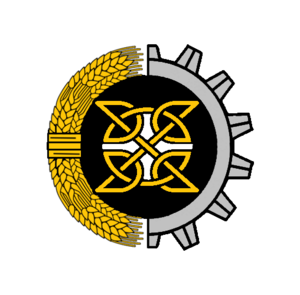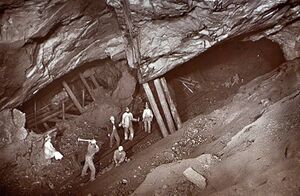Penzancian Federation
Penzancian Federation/Federal Republic of Penzancia Republik Keffrysek Pensans | |
|---|---|
| Motto: Kernow Bys Vykken | |
| Anthem: "Hail to the Homeland" "Trelawny" "An keskerdh" | |
 Map of Penzancia | |
| Capital | Penzancia (de jure) Glynawan City (de facto) |
| Largest city | Penzancia |
| Official languages | English, Cornish, Cornish English |
| Demonym(s) | Penzancian |
| Government | Federal Republic |
• President | Morwenna Fydtroust |
• Prime Minister | Catalina Calero |
| Legislature | The Cornish Senate |
| Establishment | 17 July 2021 |
| GDP (nominal) | estimate |
• Total | Unannounced |
| Currency | British Pound |
| Time zone | GMT/BST |
This article or section marked as work-in-progress has not been edited in over seven days, but further work is required. Please notify the user who first added this template. |
Penzancia, officially the Penzancian Federation, is an autonomous territorial entity which claims to be a sovereign state but is more commonly referred to as a micronation by external observers. Founded on the island of Great Britain, Penzancia declared independence from the United Kingdom in July 2021. It is an enclave and exclave country consisting of three non-contiguous pieces of land, all of which are located within the British Isles, specifically the county of Cornwall.
Penzancia is a federation of republics, these republics consist of a majority Cornish population, meaning Penzancia has the highest population by percentage of Cornish people in the world. Because of this it has embraced a "pan-Cornish" identity, embracing the idea that it acts as the sovereign protector and voice of the people of Cornwall, and their ethnic and cultural brethren. Penzancia also views itself as the successor to both the 5th Century Kingdom of Dumnonia, and the 8th Century Kingdom of Cornwall. Much of the cultural trappings of Penzancia also reflect this view, as it embraces a medieval form of Cornish and Romano-Cornish culture.
Government
Penzancia has a system of government based around the devolution of powers to regional authorities known as federal republics. Each of these republics has a self governing set of rules, and is almost entirely independent in matters of internal affairs. The three federal republics consist of the Republic of Penzance, the Republic of Stormhold and the Republic of Glynawan. Each of these republics have historically been parts of Fesmar, and thus carry a long history of being tied to eachother.
on the federal level, Penzancian government consists of three main entities, the Senate, the President and the Prime minister. The Presidency is elected yearly, whilst the senate is elected to a two month terms, and the Prime minister to a six month term. The powers of both the Prime minister and President are directly controlled by the constitution, which acts as a way of moderating the power all entities have within the federation, and to prevent an anti-democratic regime from seizing control of the republics, and wider institutions of the federation.
The Senate, officially known as the "Cornish Senate" acts as a sitting legislature for the entire federation, comprised of three representatives for each republic, along with an excess seat for the position of speaker, the senate boasts free and fair representation of devolved governments within the Penzancian state. Most notably the Senate has voted on the adoption of wider Cornish symbolism, along with voted in favour of increasing national interests across the globe.
Constituent Republics
| Flag | Government Type | Name | Population |
|---|---|---|---|
 |
Federal Republic | Penzancia | Unannounced |

|
Federal Republic | Stormhold | Unannounced |

|
Federal Republic | Glynawan | Unannounced |
Cultural Diplomacy
Penzancia has a unique culture among many internationally focused Micronations, being one of the only culturally Cornish micronations to exist on the global stage, with this, much has been done to foster a cultural union across the many Cornish populations found within micronations. Penzancia has a vested interest in the micronational affairs of Australia, Mexico and the American Rust Belt, which all have considerable populations of Cornish migrants.

The interests of Penzancia also take the form of the Cornish Union an unofficial political entity that acts as a form of confederation of Cornish populations in micronations that have them, it also acts as a form of rights advocacy group, speaking up on issues involving the people it represents. The union also seeks to be the beginnings to a unified pan-Cornish state, however so far these ideas have been limited to the confines of the Penzancian Senate.
Historically, Cornish governments have maintained close cultural and diplomatic ties to their seaward neighbours of Wales and Brittany, along with Ireland to a limited extent, the latter of which is reflected in the sizable Irish minority within Penzancia's population. The historical ties to these regions have also been maintained by Penzancia in the form of policies of automatic recognition for all Welsh and Breton Micronations, along with close diplomatic ties with its welsh neighbours.
History
Penzancian history can be divided into three main eras, the era of independence, the era of subjugation and the era of liberation. These eras correspond to the wider status of Cornwall. Because of this, Penzancian history reflects that of Cornish history throughout much of it, only the era of liberation deviating from this.
The Era of Independence
Beginning with the first settlements and populations of homo-sapiens in modern day Cornwall, this period of Penzancian history is focused around post-Roman Britain and the slow advance of the Anglo-Saxons into Cornish lands. Notably this period of time is a major inspiration for the management of food production, workers unions and the understanding of civil-administration, along with a major source of the heritage programs within the modern day that the Penzancian government promotes. It also is the source of inspiration for the an hendas mantedh, along with the probable origin period of the Myghtern a Dowr Koner, two of the most prominent monuments and historic relics found within Penzancia's borders.
The Era of Subjugation
Focused on the post 9th century Cornish, this period of time is well documented, and only ended in the 1930s with the celtic revival, during this period, tin mining was at its height, and again, this period has a major effect on Penzancia's understanding of its heritage, acting as a catalyst for the focus of Penzancian foreign affairs outside of Cornwall itself. The most notable element of this period is the massive migrations across Cornwall, for countries where the mining industry had continued to exist.

The Era of Liberation
Beginning with the Celtic revival, this period of Penzancian history, is still ongoing, and has seen the resurgence of the Cornish language, along with a reconnection to the ancient heritage of Cornwall. This period has also seen the formation of Penzancia, along with the Fesmarian attempts at Cornish self-governance. Most notably multiple areas have opened up a wider industry for preserving the Cornish heritage and identity. Many Cornish political figures have also risen during this period, such as a member of the UK's cabinet. Aside from this the major questions still exist around devolution and the future of the Cornish culture and mining industry, with many wanting to see the resurgence of it after decades of the mines being closed.

